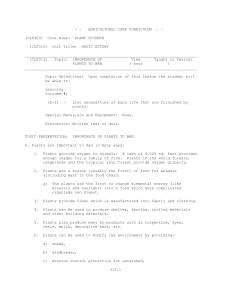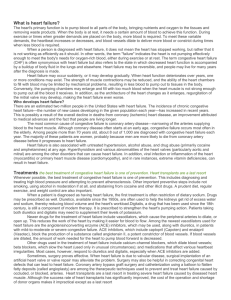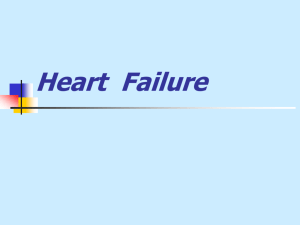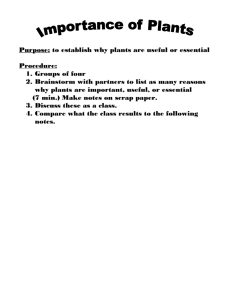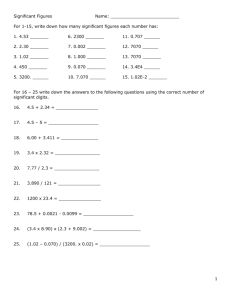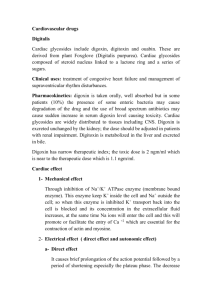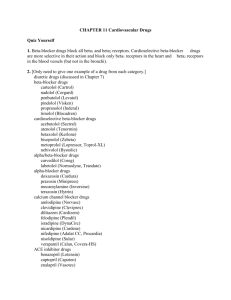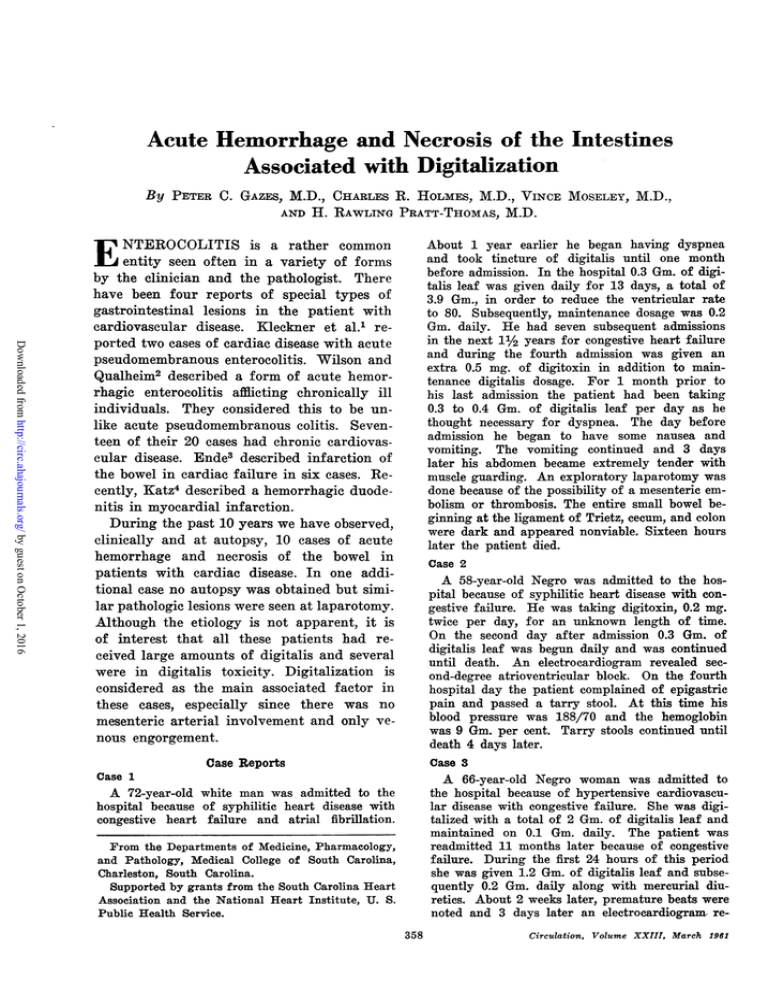
Acute Hemorrhage and Necrosis of the Intestines
Associated with Digitalization
By PETER C. GAZES, M.D., CHARLES R. HOLMES, M.D., VINcE
AND
MOSELEY,
M.D.,
HI. RAWLING PRATT-THOMAS, M.D.
ENTEROCOIJTIS is a rather common
entity seen often in a variety of forms
by the clinician and the pathologist. There
Downloaded from http://circ.ahajournals.org/ by guest on October 1, 2016
About 1 year earlier he began having dyspnea
and took tincture of digitalis until one month
before admission. In the hospital 0.3 Gm. of digitalis leaf was given daily for 13 days, a total of
3.9 Gm., in order to reduce the ventricular rate
to 80. Subsequently, maintenance dosage was 0.2
Gm. daily. He had seven subsequent admissions
in the next 11/2 years for congestive heart failure
and during the fourth admission was given an
extra 0.5 mg. of digitoxin in addition to maintenance digitalis dosage. For 1 month prior to
his last admission the patient had been taking
0.3 to 0.4 Gm. of digitalis leaf per day as he
thought necessary for dyspnea. The day before
admission he began to have some nausea and
vomiting. The vomiting continued and 3 days
later his abdomen became extremely tender with
muscle guarding. An exploratory laparotomy was
done because of the possibility of a mesenteric embolism or thrombosis. The entire small bowel beginning at the ligament of Trietz, cecum, and colon
were dark and appeared nonviable. Sixteen hours
later the patient died.
Case 2
A 58-year-old Negro was admitted to the hospital because of syphilitic heart disease with congestive failure. He was taking digitoxin, 0.2 mg.
twice per day, for an unknown length of time.
On the second day after admission 0.3 Gm. of
digitalis leaf was begun daily and was continued
until death. An electrocardiogram revealed second-degree atrioventricular block. On the fourth
hospital day the patient complained of epigastric
pain and passed a tarry stool. At this time his
blood pressure was 188/70 and the hemoglobin
was 9 Gm. per cent. Tarry stools continued until
death 4 days later.
Case 3
A 66-year-old Negro woman was admitted to
the hospital because of hypertensive cardiovascular disease with congestive failure. She was digitalized with a total of 2 Gm. of digitalis leaf and
maintained on 0.1 Gm. daily. The patient was
readmitted 11 months later because of congestive
failure. During the first 24 hours of this period
she was given 1.2 Gm. of digitalis leaf and subsequently 0.2 Gm. daily along with mercurial diuretics. About 2 weeks later, premature beats were
noted and 3 days later an electrocardiogram. re-
have been four reports of special types of
gastrointestinal lesions in the patient with
cardiovascular disease. Kleckner et al.' reported two cases of cardiac disease with acute
pseudomembranous enterocolitis. Wilson and
Qualheim2 described a form of acute hemorrhagic enterocolitis afflicting chronically ill
individuals. They considered this to be unlike acute pseudomembranous colitis. Seventeen of their 20 cases had chronic cardiovascular disease. Ende3 described infarction of
the bowel in cardiac failure in six cases. Recently, Katz4 described a hemorrhagic duodenitis in myocardial infarction.
During the past 10 years we have observed,
clinically and at autopsy, 10 cases of acute
hemorrhage and necrosis of the bowel in
patients with cardiac disease. In one additional case no autopsy was obtained but similar pathologic lesions were seen at laparotomy.
Although the etiology is not apparent, it is
of interest that all these patients had received large amounts of digitalis and several
were in digitalis toxicity. Digitalization is
considered as the main associated factor in
these cases, especially since there was no
mesenteric arterial involvement and only venous engorgement.
Case Reports
Case 1
A 72-year-old white man was admitted to the
hospital because of syphilitic heart disease with
congestive heart failure and atrial fibrillation.
From the Departments of Medicine, Pharmacology,
and Pathology, Medical College of South Carolina,
Charleston, South Carolina.
Supported by grants from the South Carolina Heart
Association and the National Heart Institute, U. S.
Public Health Service.
358
Circulation, Volume XXIII, March 1961
DIGITALIS AND INTESTINAL NECROSIS
Downloaded from http://circ.ahajournals.org/ by guest on October 1, 2016
vealed premature ventricular beats as trigeminy
and first-degree atrioventricular block. Nausea
developed, and the digitalis was stopped. Five
days later she was compensated but began to have
abdominal pain with marked tenderness. Abdominal tenderness was still present 24 hours
later and the blood pressure was stable at 120/80.
A few hours later she vomited blood and died.
Case 4
A 62-year-old white man was admitted to the
hospital because of hypertensive cardiovascular
disease with congestive failure. He had intermittent episodes of congestive failure for 4 years
and was taking 0.1 Gm. of digitalis daily. On this
admission 0.5 Gm. of digitalis leaf was given and
then 0.2 Gm. daily. The patient was readmitted
11 months later because of congestive failure and
received 0.2 Gm. of digitalis leaf daily for 11 days
when it was increased to 0.3 Gm. per day. Also,
at this time 4 ml. of digalen were given intramuscularly because of rapid atrial fibrillation.
Two days later digitoxin 0.3 mg. was given and
continued daily until death. He became compensated and his ventricular rate slowed to 86 beats
per minute. Six weeks later, however, he had a
profuse liquid black stool and complained of lower
abdominal pain. The blood pressure remained at
a level of 220/110 and the hemoglobin was 14 Gm.
per cent. A week later the patient began to vomit
and complained of epigastric pain. Nausea and
vomiting continued for 3 days until he died after
a hematemesis.
Case 5
A 71-year-old Negro man was admitted to the
hospital in congestive heart failure with a diagnosis of hypertensive cardiovascular disease. He
received 1.6 Gm. of digitalis leaf and was maintained with 0.1 Gm. daily. The patient was readmitted to the hospital 20 months later and the
digitalis was increased to 0.2 Gm. per day. Subsequently digoxin, 0.25 mg. twice per day, was
given instead of digitalis leaf. He was readmitted 21/2 years later because of an injury to his
right leg of 1 month's duration. He appeared to be
compensated and was maintained on 0.2 Gm. of
digitalis leaf per day. After 2 weeks he developed
extreme generalized abdominal tenderness and voluntary rigidity with active peristalsis and died
several hours later.
Case 6
An 81-year-old white woman was admitted to
the hospital because of arteriosclerotic heart disease with congestive heart failure. She had been
digitalized previously and was on maintenance
dosage and metcaptomerin (Thiomerin) 2 ml. intramuscularly per week. Two days prior to admission she began to have nausea and vomiting.
Circulation, Volume XXIII, March 1961
359
The electrocardiogram revealed left ventricular
hypertrophy, ST-T changes of digitalis, and ventricular bigeminy. The vomiting continued over
a 24-hour period with vague generalized abdominal
pain and tenderness and slight distention. Digitalis was discontinued, and a Levine tube was
passed. Forty-eight hours after admission she
suddenly became unconscious, developed a very
irregular rhythm, and died.
Case 7
A 55-year-old Negro woman was admitted to
the hospital with a cerebral vascular accident and
rapid atrial fibrillation. She received a total of
2 mg. of lanatoside C (Cedilanid) intravenously
over an 8-hour period with a slowing of the ventricular rate from 180 to 120. In spite of supportive therapy she weakened rapidly and died 10
hours after admission.
Case .8
A 72-year-old white man was admitted to the
hospital because of arteriosclerotic heart disease
with congestive heart failure. For 2 years prior
to admission he had intermittent episodes of congestive failure requiring increases in his maintenance digitalis and diuretics. The day prior to
admission an additional 1 mg. of digoxin was given
and maintenance was started of digitalis leaf,
0.2 Gm. daily. While in the hospital the patient
received diuretics, 2 ml., and potassium solution
three times per day. Episodes of sudden dyspnea
and cough occurred and anticoagulation was started
because of the possibility of pulmonary emboli.
After 1 week he began to have epigastric pain,
which gradually increased with generalized abdominal tenderness. He progressively weakened
and died 2 days later.
Case 9
A 68-year-old Negro woman was admitted to
the hospital because of hypertensive arteriosclerotic
heart disease with congestive heart failure. Three
days prior to admission she was given gitalin 2.5
mg. followed with 0.75 mg. every 6 hours for six
doses, with a maintenance of 0.5 mg. daily. She
also was receiving chlorothiazide, 500 mg. daily.
The first day in the hospital 1 mg. of gitalin was
given and subsequently 0.1 Gm. of digitalis leaf
daily. On admission the patient complained of
mild nausea and anorexia. An electrocardiogram
revealed first-degree atrioventricular block with
periods of complete block. The following day the
nausea and anorexia became worse and she had
vague abdominal pain. At this time the electrocardiogram revealed atrioventricular dissociation
with interference beats. She passed several bloody
stools and had some drop in blood pressure but
did not develop shock. The abdominal pain increased and bright red blood was passed through
360
GAZES, HOLMES, MOSELEY, PRATT-THOMAS
Downloaded from http://circ.ahajournals.org/ by guest on October 1, 2016
a gastric tube. The blood pressure gradually fell
and she died 3 days later.
Case 10
A 75-year-old white woman weighing about 70
pounds was admitted to the hospital with arteriosclerotic heart disease and digitalis toxicity. She
had dyspnea for about 6 months prior to admission. Each attempt at digitalization produced
nausea. Two weeks prior to death she was given
digitoxin, 0.2 mg. twice per day, for 1 week then
0.2 mg. daily. She also took Trilafon, which prevented nausea, and 500 mg. of chlorothiazide daily.
A few days prior to admission an electrocardiogram showed first-degree atrioventricular block
and there was no evidence of heart failure. Admission was necessary because of nausea, vomiting,
rapid heart beat, and lower left abdominal pain.
The patient was found to be compensated with a
blood pressure of 150/90, and there was some
tenderness over the left lower quadrant. An electrocardiogram revealed long runs of ventricular
tachycardia. She was given 40 mEq. of potassium
chloride and 500 ml. of glucose in water with
clearing of the ventricular tachycardia and appearance of atrial fibrillation. Over 24 hours the abdominal pain became worse and the blood pressure
gradually dropped. She became distended and
had marked tenderness in the left lower abdominal
quadrant and absent peristalsis. Laparotomy was
performed because of the possibility of a mesenteric embolism. The small bowel and entire colon
were discolored and appeared to be in varying
stages of gangrene. The ileocecal area was involved most. The stomach was normal and the
mesenteric arteries appeared patent. The mesenteric veins were congested and thrombosed at the
junction of the venules to the bowel. A few hours
after surgery the patient died. No autopsy was
obtained.
Case 11
A 60-year-old Negro woman was admitted to the
hospital because of arteriosclerotic heart disease
and digitalis toxicity. She was digitalized about
5 years prior to admission and subsequently took
0.1 Gm. of digitalis leaf a day. During the past
few months she increased this to twice a day and
began to have nausea and vomiting 1 week prior
to admission. On admission an electrocardiogram
revealed first-degree atrioventricular block and periods of atrioventricular dissociation. The patient
appeared compensated and was given intravenous
fluids and oral potassium salts. Epigastric pain
was noted on the day of admission. Digitalis
was resumed at a dose of 0.1 Gm. daily, 3 days
after admission. Two days later the abdominal
pain became more severe and she gradually became distended with generalized tenderness, re-
bound tenderness, and hypoactive peristalsis. Mesenteric thrombosis was considered, and laparotomy
was performed. During this procedure her blood
pressure dropped and she required l-arterenol. At
surgery, the entire large bowel was discolored
greenish black, it contained hemorrhagic material,
and its walls were friable. The entire jejunum,
colon, and ileum, except for a central five feet,
were similarly discolored. All of the bowel was
edematous. There was no evidence of mesenteric
thrombosis. Extensive resection of involved areas
was performed, but the patient died 2 hours later.
Comment
The common denominator in these cases was
digitalization with definite digitalis toxicity
in seven. All these cases were autopsied except case 10, in which the abdomen was
explored. The intestinal lesions resembled
those described by Wilson and Qualheim2 and
by Ende.3
Grossly the intestine is described characteristically as showing marked venous engorgement with hemorrhage and edema of the wall.
In the most heavily implicated areas it is
purplish or reddish black. These changes are
likely to be described as gangrenous by the
surgeon or by the pathologist. In the strict
sense it is not gangrene, since there is usually
very little inflammatory reaction and no
massive infarction. There is epithelial devitalization, and in cases that live for a sufficient
length of time mucosal necrosis, ulceration,
and secondary infection will supervene. The
darkening of the intestine is due to the profound venous engorgement (fig. 1), which
may be further intensified by blood in the
lumen and mucosa. In eight cases there was
blood in the lumen of the bowel. The intestinal
wall is commonly friable.
Careful dissection of the mesenteric arterial
system revealed no instance of thrombosis. In
only one instance was there a significant
degree of mesenteric arteriosclerosis, and this
did not severely compromise the lumen. Venous thrombi were occasionally observed. In
two cases thrombi were present at the mesenteric-enteric junction, but were obviously very
recent and secondary to the venous stasis.
Thrombi occurred in a few other instances but
were related to inflammation and ulceration.
Circulation, Volume XXIII, March 1961
361
DIGITALIS AND INTESTINAL NECROSIS
Downloaded from http://circ.ahajournals.org/ by guest on October 1, 2016
Microscopically the most conspicuous feature is the profound degree of venous engorgement, which is most evident in the submucosa,
(fig. 2). Hemorrhage into the mucosa and
edema of the submucosa are constant findings.
The gastrointestinal tract in this condition
is not uniformly involved and most commonly
shows a segmental or patchy distribution.
The stomach was involved in only three instances and seldom to the degree observed in
the intestine. Gastric ulcers were present
in two others. Some portion of the small
intestine was implicated in all instances and
the degree of involvement was usually extensive. In four cases the entire small intestine
showed conspicuous edema, congestion, and
hemorrhage. In two, the ileum was the only
portion of the small intestine affected. In one
case the vascular engorgement was limited
to the jejunum, and in three others various
combinations of involvement of the duodenum, jejunum, and ileum were observed. It
was remarkable that an uninvolved segment
of intestine could occur with massive changes
in the contiguous bowel. In four patients the
entire colon showed congestive and hemorrhagic phenomena. In one there was no change
in the large bowel. Patchy involvement of the
colon occurred in the other five cases and in
two of these the process did not extend beyond
the cecum.
Six of the cases were judged pathologically
to be in congestive failure. The presence of
failure was based on peripheral edema, excess fluid in the serous cavities, pulmonary
edema, and chronic passive congestion of the
liver. The liver revealed chronic passive congestion in three cases, sinusoidal congestion
in four cases, and no abnormality in four.
Those with chronic passive congestion had
definite digitalis toxicity.
Discussion
Kleckner et al.1 considered their cardiac
cases to have acute pseudomembranous enterocolitis. This form of enterocolitis has been
reported in a variety of other situations, such
as after surgery, during antibiotic therapy,
with shock, and with staphylococcal infecCirculation, Volume XXIII, March 1961
Figure 1
Transilluminated segment of small intestine showing profound venous engorgement with areas of
mucosal hemorrhage.
tions. Wilson and Qualheim2 described in 17
cases of chronic cardiovascular disease a form
of acute hemorrhagic enterocolitis that they
considered to be unlike the acute pseudomembranous type. Their cases were very similar pathologically to those described in this
paper. The only common denominator noted
by the authors was cardiovascular disease
with congestive failure. They mentioned that
"the temporal relationship to vigorous therapy for heart failure with digitalis or digitoxin and with mercurial diuretic agents is
striking in many instances, and it is tempting
to ascribe causal relationship to any one of
these agents." Ende3 was of the opinion that
infarction of the bowel can occur with severe
cardiac failure in the presence of insignificant
vascular disease of the mesenteric vessels. He
encountered this in six cases and described
in detail the three most severe ones. In the
milder cases, various segments of small bowel
were hemorrhagic and the lumen contained
frank blood. He believed that these changes
represented mild pathologic changes associated with severe cardiac failure by contrast
with the much more serious lesion of infarction of the bowel. It was postulated that severe
cardiac failure, perhaps aided by vascular
spasm, can produce ischemia severe enough
to lead to infarction.
Wilson and Qualheim2 mentioned that the
liver was chronically congested in one case
but did not mention the hepatic status in
the others. They did not mention whether or
not mesenteric vein congestion was present
nor did they note the digitalization status
GAZES, HOLMES, MOSELEY, PRATT-THOMAS
362
Downloaded from http://circ.ahajournals.org/ by guest on October 1, 2016
Figure
2
Distended veins in the edematous submucosa of
the intestine. Mucosal hemorrhage is apparent in
the upper left. Note the absence of inflammatory
reaction.
of the patients. Ende3 mentioned liver congestion in only one of his patients and in
another that the blood vessels of the mesentery
of the bowel had evidence of congestion but
no thrombi. The first of his cases was given
digitalis and mercurials but the amounts were
not mentioned. A run of ventricular tachycardia occurred in this case. The second case
had atrial fibrillation and ventricular bigeminy and was given diuretics and potassium
chloride but the amount of digitalis was not
stated. The third case had first-degree heart
block and was on digitoxin, 0.2 mg. daily.
Portal Congestion Associated with Digitalization
in Experimental Conditions
In view of the considerable experimentation
and discussion related to the effects of digitalis glycosides on the liver and portal system,
it is possible an extracardiac action of digitalis, especially in overdosage, produces pooling of blood in the splanchnic venous system.
In 1932 Bauer et al.5 concluded from work
on isolated perfused livers that there was a
"sluice or sphincter mechanism" in the livers
of dogs. The sphincter mechanism was located
near the caval orifices of the main hepatic
veins. Epinephrine opened and histamine
closed the sluice while both drugs appeared
to exert a weak constrictive action on the
deeper veins. Specific localization of hepatic
sphincters and their dynamic role in circula-
tory adjustments have been reviewed at length
by Knisely and associates.6 7 Dock and
Tainter8' 9 particularly formulated the interp:-etation that digitalis, in addition to its
cardiac effect, acts to reduce active circulating
blood volume by pooling blood in the splanchnic area through constrictive effects in the
hepatic veins. Their experimental observations were supported by those of Katz and
associates10 and, to some degree, by those of
Nadler and associates,"1 although the latter
were led to question the significance of this
extracardiac action of digitalis. McMichael
and Sharpey-Schafer12 considered that digitalis may produce its immediate beneficial
effect by lowering of the venous pressure,
which could be on a basis of constriction of
the portal venules in the liver. Thomas and
Essex13 demonstrated that spasm of the hepatic vein could be produced by anaphylactic
shock, histamine, digitoxin, hydatid cyst fluid,
and anoxia. Eddleman et al.'4 studied the
effect of oral digitoxin in 12 normal subjects
with the use of the electrokymograph and
concluded that it acts to decrease the volume
of blood returned to the heart and to increase
force of cardiac contraction. More recently,
Cotten and associates have used current methods to measure the effects of cardiac glycosides in reducing venous return and cardiac
output15 in the absence of important changes
in total plasma volume or extracellular
water.'6 These various hemodynamic studies
offer indirect but highly suggestive evidence
that digitalis exerts constrictive effects in the
liver or hepatic vein structures. Such effects
presumably can occur to a marked degree
with excessive digitalization. Hueper and
Ichiniowski17 found marked congestion and
engorgement of the liver with areas of necrosis, hyalinization, and edema in animals
poisoned with digitalis leaf.
Clinical Considerations
Congestive failure, especially when chronic
in nature, can be an additive factor with
overdigitalization. At autopsy, however, four
of our cases did not manifest congestive failure and many were clinically compensated
Circulation, Volume XXIII, March
1961
363
DIGITALIS AND INTESTINAL NECROSIS
Downloaded from http://circ.ahajournals.org/ by guest on October 1, 2016
when they developed abdominal symptoms.
If congestive failure were the sole cause, then
we would expect to see this bowel syndrome
more often. Only one of our patients, case
8, had received an anticoagulant, and the
prothrombin times in this case were in a
satisfactory range. Friedman et al.'8 demonstrated in dogs that during hemorrhagic
shock or administration of epinephrine, constriction of the portal and hepatic veins
occurred. Because of the sustained intrahepatic resistance, intestinal hemorrhage and
even hemoperitoneum eventually occurred. In
our cases there was no evidence of shock prior
to or during this syndrome. Five patients
had received a mercurial diuretic but this has
been discounted as a factor.
This syndrome can be suspected when a
patient develops abdominal pain while receiving large amounts of digitalis; unnecessary surgery thus may be avoided. Frequently
a diagnosis of mesenteric thrombosis or embolism is suggested. Abdominal examination
and flat plates do not reveal any characteristic
diagnostic feature. It is well to stress again,
especially with the advent of so many new
preparations, that patients should be digitalized with caution. The antiemetic tranquilizer drugs are often given during
digitalization, and so the early nausea of
digitalis toxicity may be masked, as occurred
in case 10. Also, maintenance digitalis alone
can produce toxicity in the presence of
potassium loss, such as occurs with diuretics
and steroids.
Summary
Eleven cases with acute hemorrhage and
necrosis of the bowel are described. In all
cases there was high dosage of digitalis and
definite toxicity in seven. Digitalis was considered as the main associated factor, especially since there was no mesenteric arterial
involvement and, in four cases, there was no
congestive failure at autopsy. Hepatic vein
or sinusoidal sphincter constriction with resulting portal splanchnic venous congestion
was considered as possible mechanisms by
which digitalization produced this syndrome.
Circulation, Volume XXIII, March 1961
Acknowledgment
We wish to express our appreciation to Dr.
Robert Walton for reviewing this manuscript.
References
1. KLECKNER, M. S., BARGER, J. A., AND BAGGENSTOSS, A. H.: Acute pseudomembranous enterocolitis. Proc. Staff Meet., Mayo Clin. 28: 313,
1953.
2. WILSON, R., AND QUALHEIM, R. E.: A form of
acute hemorrhagic enterocolitis afflicting chronically ill individuals. Gastroenterology 27: 431,
1954.
3. ENDE, N.: Infarction of bowel. New England
J. Med. 258: 879, 1958.
4. KATZ, A. M.: Hemorrhagic duodenitis in myocardial infarction. Ann. Int. Med. 51: 212,
1959.
5. BAUER, W., DALE, H. H., PouLSSoN, L. T., AND
RICHARDS, D. W.: The control of circulation
through the liver. J. Physiol. 74: 343, 1932.
6. KNISELY, M. H., BLOCH, E. H., AND WARNER, L.:
Selective phagocytosis. I. Microscopic observations concerning the regulation of the blood
flow through the liver and other organs.
7.
8.
9.
10.
11.
12.
13.
Kong. Dansk. Videnskab. Selskab. Biolog.
Skrift. IV, nr 7: 1948.
KNISELY, M. H., HARDING, F., AND DEBACKER,
H.: Hepatic sphincters-brief summary of
present day knowledge. Science 125: 1023,
1957.
DOCK, W., AND TAINTER, M. L.: The circulatory
changes after full therapeutic doses of digitalis
with a critical discussion of views on cardiac
output. J. Clin. Invest. 8: 467, 1929.
TAINTER, M. L., AND DOCK, W.: Further observations on the circulatory actions of digitalis
and strophanthus with special reference to
the liver, and comparisons with histamine
and epinephrine. J. Clin. Invest. 8: 485, 1929.
KATZ, L. N., RODBARD, S., FRIEND, M., AND
ROTTERSMAN, W.: The effect of digitalis on
the anesthetized dog. I. Action on the splanchnic bed. J. Pharm. & Exper. Therap. 62:
1, 1938.
NADLER, J. E., BERGEn, A. R., AND BALLINGER,
J.: Action of ouabain on the splanchnic circulation in the dog. J. Lab. & Clin. Med. 25:
557, 1939.
MCMICHAEL, J., AND SHARPEY-SCHAFER, E. P.:
The action of intravenous digoxin in man.
Quart. J. Med. 13: 123, 1944.
THOMAS, W. D., AND ESSEX, H. E.: Observations
on the hepatic-venous circulation with special
reference to the sphincteric mechanism. Am. J.
Physiol. 158: 383, 1959.
364
34GAZES, HOLMES, MOSELEY, PRATT-THOMAS
14. EDDLEMAN, E. E., JR., WILLIS, K., GREVE, M. J.,
AND HEYER, H. E.: The effect of digitoxin
on the apparent stroke volume, postero-anterior
cardiac diameter, and the cardiac cycle in
normal subjects as studied by the electrokymograph. Am. Heart J. 41: 161, 1951.
15. COTTEN, M., DEV., AND STOPP, P. E.: Action of
digitalis on the nonfailing heart of the dog.
Am. J. Physiol. 192: 114, 1958.
16. COTTEN, M. DEV.: Effect of cardiac glycosides
on plasma volume in the dog. The Pharmacologist 1: 63: 1959.
17. HUEPER, W. C., AND ICHNIOWSKI, C. T.: Experimental studies in cardiovascular pathology. II.
Pathologic lesions in organs of cat, guinea
pigs, and frogs produced by digitalis poisoning.
J. Lab. & Chem. Med. 26: 1565, 1941.
18. FRIEDMAN, E. W., FRANK, H. A., AND FINEY,
J.: Portal circulation in experimental hemorrhagic shock. Ann. Surg. 134: 70, 1951.
9nt
Downloaded from http://circ.ahajournals.org/ by guest on October 1, 2016
I made a bladder very supple by wetting of it, and then cut off so much of the neck
as would make a hole wide enough for the biggest end of the largest fosset to enter, to
which the bladder was bound fast. The bladder and fosset contained 74 cubick inches.
Having blown up the bladder, I put the small end of the fosset into my mouth: and at
the same time pinched my nostrils close, that no air might pass that way, so that I
could only breathe to and fro the air contained in the bladder. In less than half a
minute I found a considerable difficulty in breathing, and was forced after that to fetch
my breath very fast; and at the end of the minute, the suffocating uneasiness was so
great, that I was forced to take away the bladder from my mouth. Towards the end of
the minute the bladder was become so flaccid, that I could now blow it above half full
with the greatest expiration that I could make.-STEPHEN HALES, B.D., F.R.S. Vegetable Statics, 1727.
Circulation, Volume XXIII, March 1961
Acute Hemorrhage and Necrosis of the Intestines Associated with Digitalization
PETER C. GAZES, CHARLES R. HOLMES, VINCE MOSELEY and H.
RAWLING PRATT-THOMAS
Downloaded from http://circ.ahajournals.org/ by guest on October 1, 2016
Circulation. 1961;23:358-364
doi: 10.1161/01.CIR.23.3.358
Circulation is published by the American Heart Association, 7272 Greenville Avenue, Dallas, TX
75231
Copyright © 1961 American Heart Association, Inc. All rights reserved.
Print ISSN: 0009-7322. Online ISSN: 1524-4539
The online version of this article, along with updated information and services, is
located on the World Wide Web at:
http://circ.ahajournals.org/content/23/3/358
Permissions: Requests for permissions to reproduce figures, tables, or portions of articles
originally published in Circulation can be obtained via RightsLink, a service of the Copyright
Clearance Center, not the Editorial Office. Once the online version of the published article for
which permission is being requested is located, click Request Permissions in the middle column
of the Web page under Services. Further information about this process is available in the
Permissions and Rights Question and Answer document.
Reprints: Information about reprints can be found online at:
http://www.lww.com/reprints
Subscriptions: Information about subscribing to Circulation is online at:
http://circ.ahajournals.org//subscriptions/

